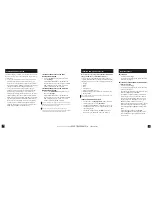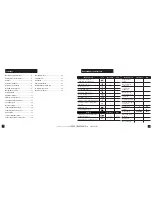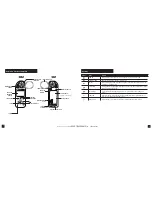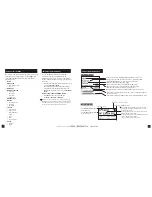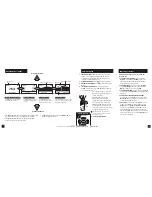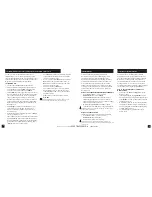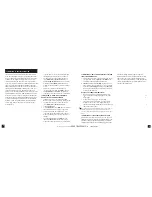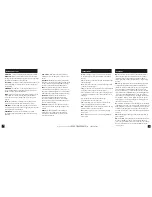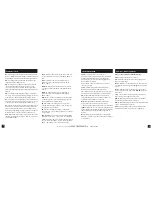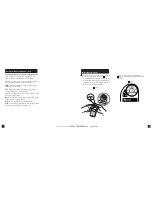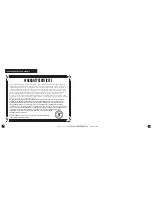
15
14
An accurate crosswind measurement requires that the
Kestrel “know” both the direction of fire and the wind
direction and strength. You may use the Kestrel’s built-in
compass and wind measuring and averaging features to
capture these values:
CAPTURING THE DIRECTION OF FIRE:
» Select
Tgt
to enter the Target menu, scroll down and
select
DoF,
then scroll down and select
Capture
.
» Follow the on-screen instructions:
» While holding the Kestrel vertical, point the back
of the unit directly towards the target and select
Capture.
»
DoF
will automatically be populated in the Target
menu.
MEASURING WIND
CAPTURING THE WIND INPUTS:
» In the Target menu, scroll down and select
WD,
WS1, or WS2.
» Scroll down and select
Capture.
» Follow the on-screen instructions:
» While holding the Kestrel vertical, point the
back of the unit directly into the wind and
select
Capture.
» Continue to point the Kestrel into the wind
for
at least 5 seconds
to capture a sample of
the winds. Select
End Capture
.
»
WD, WS1, WS2
will automatically be populated
in the Target menu.
Note! Selecting Wind in the Ballistics Menu jumps directly to the
WD, WS1, & WS2
entries in the Target Menu.
Note! For maximum accuracy of compass readings when
capturing DoF and Wind, the Kestrel must be held as vertically
as possible – be careful not to tilt it away from you while taking
readings.
Note! Any time you are using the Kestrel to calculate an elevation
hold (including when calibrating muzzle velocity and DSF) a
direction of fire plus wind direction and speeds must be input.
These inputs contribute to an accurate elevation solution.
The Muzzle Velocity Calibration function allows you to
obtain a more accurate muzzle velocity by combining
user input data and actual shot results and calculating the
actual bullet speed.
CALIBRATING MUZZLE VELOCITY:
» Scroll to and select
Gun
in the Ballistics Menu.
» After accurately inputting all other gun, bullet, and
scope parameters, as well as wind values and direction
of fire, scroll to
MV
and adjust to your best estimate of
your gun’s muzzle velocity.
» Select
MV
to enter the MV sub menu. Scroll to and
select
Cal MV.
» The
Cal MV
range is the suggested target distance
at which to calibrate. For best results, find a range
where you can shoot to between 90% and 100% of the
recommended range but no further. Calibrating at less
than 90% of the recommended range will lessen accu-
racy and less than 80% or beyond the recommended
range will not be valid.
» Adjust
Range
to match the actual distance to your
target where you are shooting. Accuracy here is key!
Use a quality ranger finder if you are not on a measured
range.
» Apply the suggested elevation hold shown in
Drop
in
your scope turrets or reticle.
CALIBRATING MUZZLE VELOCITY
» Take a number of shots to determine the actual
bullet drop. Adjust
Drop
to match the actual
observed bullet drop of the bullet at that range.
For example, if the point of impact is 1.5 Mils
below the bullseye adjust the
Drop
value to be
1.5 Mils greater.
» A new
MV
will be automatically calculated to
match the actual impact of your round. (In this
example, the
MV
will be decreased.) No chrono-
graph required!
» A (+) or (-) in front of the
MV
value indicates the
new
MV
has been calibrated up or down.
» Exit to accept the new
MV
value.
Note! The suggested MV Cal range is the distance where the bullet
slows to Mach 1.2. If the suggested range cannot be matched it
is better to shoot at a shorter/closer distance rather than further.
However, as the MV calibration range decreases, so does MV
calibration accuracy. Try to shoot as close to the recommended
MV Cal range as possible.
Note! If the MV-Temp table has been populated, MV values
will be locked by the MV-Temp table and MV values will not be
automatically adjusted by the MV Cal procedure above.
Shop for Quality products online at:
1.888.610.7664
www.
SCOUTBASECAMP
.com


